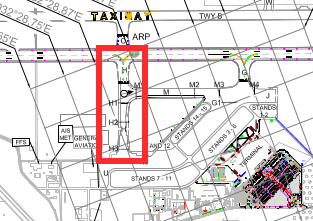- Standard circuit pattern RWY29 left-hand and RWY11 right-hand.
- Aircraft shall not overfly the terminal buildings, military base, airport fuel facilities and apron areas.
- Aircraft should enter LIMASSOL TRAINING AREA via PACHNA and exit via KOURIS.
- Aircraft should enter AKAMAS TRAINING AREA via WEST of AKOURSOS and exit via EAST of AKOURSOS.
- Aircraft should enter POLEMI TRAINING AREA via WEST of LETYMVOU and exit via EAST of LETYMVOU.
- When LCTSA09 (Temporary Segregated Area CHRYSOCHOU BAY)
LCD38 is active, POLEMI and AKAMAS TRAINING AREAS are closed.
3.3 GROUND PROCEDURES
- Pilots shall contact Ground Control 130.625 MHz for start-up clearance, reporting parking position and intentions as per filed flight plan.
- Aircraft located at General Aviation Apron shall expect to taxi via taxiway H unless otherwise instructed by ATC.
- Pilots shall exercise caution and maintain lookout for vehicular movements when crossing the service road.
- Light aircraft may be instructed to hold at intermediate holding point H1, located south of the intersection of taxiways H and M, as to allow other aircraft ground movement via taxiway M.
- Unless otherwise instructed by ATC, whether RWY29 or RWY11 in-use, departing light aircraft taxi to runway holding point via taxiway H, and arriving aircraft vacate runway via taxiway H to hold at H2.
- Arriving aircraft shall report to ATC when parked and shutting down.
3.4 RADIO COMMUNICATION FAILURE PROCEDURES
The aircraft shall attempt to establish communications with the appropriate
ATS unit using all available means. In addition, the aircraft, when forming part of the aerodrome traffic at a controlled aerodrome, shall keep a watch for such instructions as may be issued by visual signals.
The procedures to be followed when
VFR traffic experiences radio communication failure at LCPH are described below:
- Aircraft north LCPH
- Set transponder A7600.
- Arrive north-abeam the Control Tower maintaining last assigned altitude.
- Orbit abeam the Control Tower and descend to 1000 FT.
- Find out the runway in use by observing the windsock and the aerodrome traffic.
- Look out for light signals from Control Tower.
- Rock the wings as acknowledgement when observing the signal, and
FLASHING GREEN: return for landing via right downwind RWY29 or left downwind RWY11.
STEADY GREEN: cleared to land.
STEADY RED: continue orbiting north abeam and observe light signals.
- Aircraft south LCPH over the sea
- Set transponder A7600.
- Arrive on downwind south-abeam the Control Tower maintaining last assigned altitude.
- Orbit abeam the Control Tower and descend to 1000 FT.
- Find out the runway in use by observing the windsock and the aerodrome traffic.
- Look out for light signals from the Control Tower.
- Rock the wings as acknowledgement when observing the signal, and
FLASHING GREEN: return for landing via right downwind RWY11 or left downwind RWY29.
STEADY GREEN: cleared to land.
STEADY RED: continue orbiting on downwind and observe light signals.
3.5 GO AROUND
In case of go-around, aircraft shall climb 1000 FT, join the standard circuit pattern (proceed over the sea) and contact ATC.
If go-around is executed due to loss of radio communication, aircraft shall climb 1000 FT, join the standard circuit pattern, and follow the
RCF procedure.


